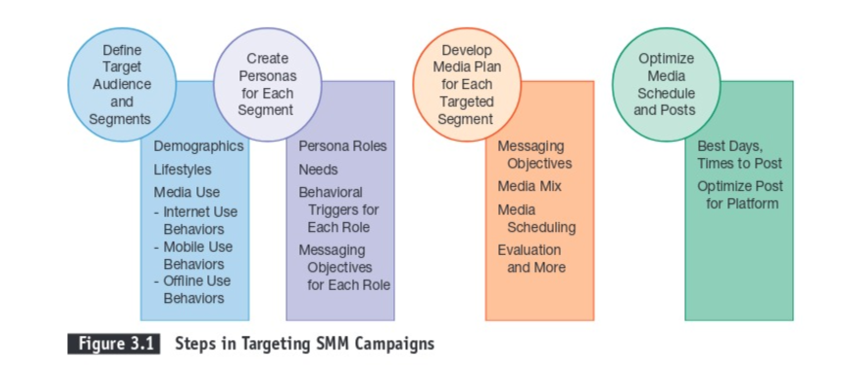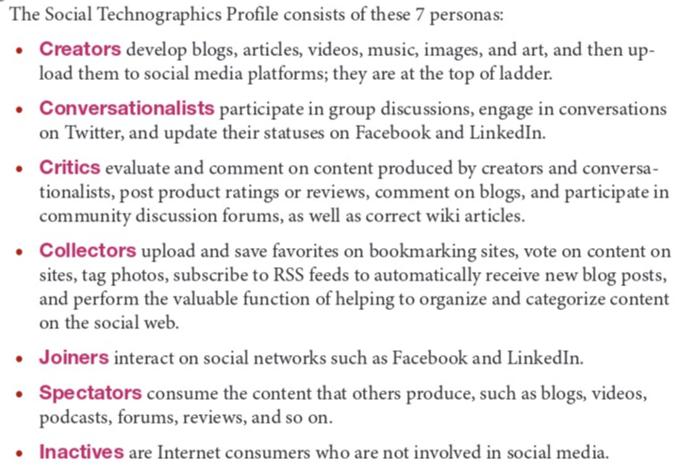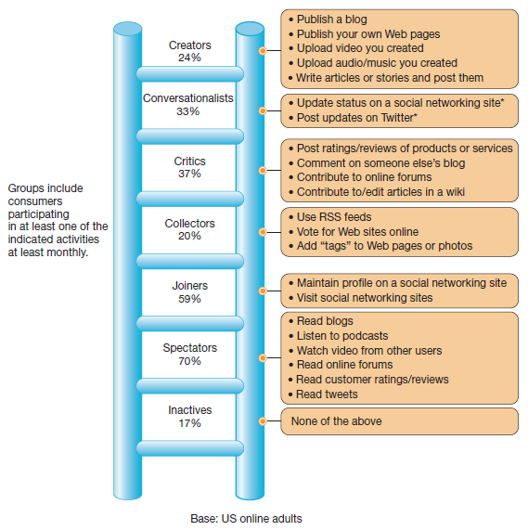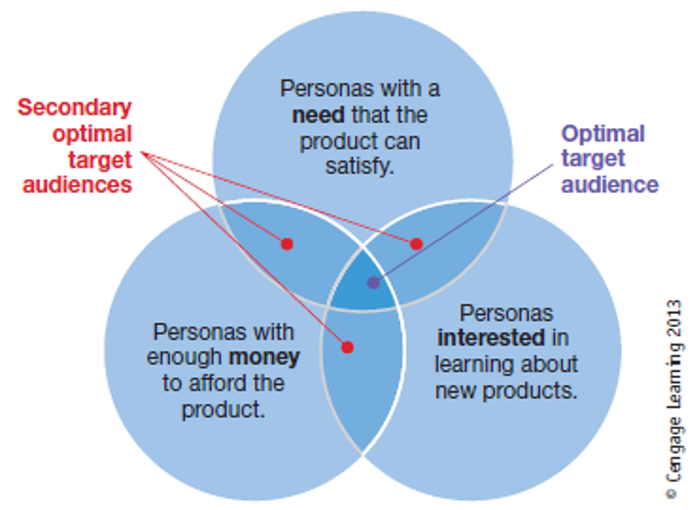Lecture 3 Identifying Target Audiences
1/25
There's no tags or description
Looks like no tags are added yet.
Name | Mastery | Learn | Test | Matching | Spaced |
|---|
No study sessions yet.
26 Terms
Define a Target (Market) Audience
Marketers target specific segments whose needs they believe the brand is capable of satisfying in exchange for meeting organizational objectives.
Market segmentation is the process of dividing the market into distinct groups that have common needs and characteristics.
Geographic
Demographic
Psychographics
Benefits sought & behavioral
Strategies to Segment the Market
•One product one market
•One product multiple markets
•Multiple products multiple markets
•Mass Customization
Geographic Segmentation Base
Dividing the market based on the location – zipcode, city, state, country, continent
Geofencing - virtual line around a defined geographic space, as people with a geolocation mobile app enter a defined area, they can be targeted with ads or offers.
Beaconing – has a very small range and is best for targeting locations within a store.
Demographic Segmentation Base
Age, income, gender, ethnic background, family life cycle & occupation
Psychographic Segmentation Base
Based on personality, motivation, motives, lifestyles, values and attitudes and opinions.
Provide richest picture of a consumer segment in that the descriptions of psychographic segments help marketers to know the real person making the consumption decisions.
Benefit Segmentation Base
Based on the benefits they seek from the products available in the market. For Example- in the auto industry people who buy hybrids and electric cars look for different benefits than those who buy muscle cars or SUVs.
Behavioral Segmentation Base
•Divides consumers based on their actions
•Variables include – product research sources, the nature of the purchase, brand loyalty, usage level, frequency of purchase, distribution channel.
•For social media we need to take one step further – here are the variables that we need to use to form social profiles and Social Technographics
•how much time prospective customers spend online and on social media
•what activities they participate in on social media (social technographics)
•which social networks do they use &
•the devices they use to access social media
Steps in Targeting Social Media Campaigns

Define Buyer Persona
•Personas are fictional or generalized representation of your ideal customers
•Marketers use the various bases of segmentation to construct buyer personas
Personas are defined by an individual’s underlying need. These underlying needs are not easily observable; they go deep within a person’s heart. These underlying needs become the motivation for certain sets of behavior that individuals exhibit.
•It’s important to define personas -
•Marketers are better able to identify, understand, acquire, engage, and retain the target audience.
•Each persona will have a different set of interests, needs, and communication styles
•Detailed client personas help you understand your target audience and design a content strategy that is targeted at specific, defined audiences.
•Example – Target market are women between 25-40 years.
Content Strategy
•what you want to share
•where you want to post it
•how you want to promote it
•when is the best time to post it
•
The Forrestor Social Technographics Ladder

Social Technographics Ladder

The Persona Development Cycle
Three-Step Persona Development Cycle, which was created by Michelle Golden
1.Identify Persona Roles, listing all relevant personas by role
2.List Needs and Situational Triggers from personas’ perspectives, defining concerns, symptoms, and problems
3.Create Messaging Objectives suited to each persona’s needs that you have the expertise to address (and note those that you don’t)
Determining the Optimal Target Audience
Three sets of personas exist in the overall market:
1.Personas with a need that the product being marketed satisfies
2.Personas with enough money to purchase the product
3.Personas generally interested in receiving information about new products
Where all three attributes overlap makes
up the optimal target audience.
EXAMPLE:
Suppose a company is selling online security tools designed to protect user privacy.
Consider five buyer personas:
•Top executives or managers of companies (CEO)
•Beginning Internet users just starting out (new)
•High school/college-aged Internet users who spend large amounts of time on the web (student)
•Young professionals in tech-driven industries (yuppie)
•Middle-aged to senior citizens who are less familiar with the Internet (older)

Persona + Social Exhaust = Social Identity
•Social identity is part of our self-concept (a sense of who we are) that results from our perceived membership in a group
•Depends on our aspirational and our actual groups we refer to as the basis of our self appraisal
•Actual group
•Social identity can influence where, when, how, and what you contribute as a social media participant
•Marketers are interested in your social identity- along with other information useful for segmenting & targeting you!
Where do they get this data from?
•As you participate online, you leave behind residue, sometimes called social exhaust
•The residue becomes a source of big social data (BSD)
•Data generated from technology mediated social interactions and actions online, which can be collected and analyzed.
Marketers assess this information, the portrait they paint of you is their view of your social identity
•Altimeter defines the marketer’s view of social identity as “the information about an individual available on social media, including profile data and ongoing activity”
•Altimeter believes using social identity data helps brands to build richer customer profiles, efficiently use marketing budgets, and engage across channels
What is Social Identity
•Social identity is part of our self-concept (a sense of who we are) that results from our perceived membership in a group
•Depends on our aspirational and our actual groups we refer to as the basis of our self appraisal
•Actual group
•Social identity can influence where, when, how, and what you contribute as a social media participant
•Marketers are interested in your social identity- along with other information useful for segmenting & targeting you!
How do they get social identity data? What is social exhaust
•As you participate online, you leave behind residue, sometimes called social exhaust
•The residue becomes a source of big social data (BSD)
•Data generated from technology mediated social interactions and actions online, which can be collected and analyzed.
•Marketers assess this information, the portrait they paint of you is their view of your social identity
•Altimeter defines the marketer’s view of social identity as “the information about an individual available on social media, including profile data and ongoing activity”
•Altimeter believes using social identity data helps brands to build richer customer profiles, efficiently use marketing budgets, and engage across channels
•Identify prospects at all points in the purchase funnel
•Nurture leads
•Tailor recommendations. Follow up customers to retain attention
•Reward loyalty
Behavioral Targeting
based on purchase behavior or behaviors that convey intent like search behaviors
Connection Targeting
based on the type of connection to your brand page, such as a Facebook fan
Social Identity depends on-
Social Touchpoints
Interest Targeting
Based on self reported interest and page-related behaviors like search
Look-Alike Targeting
Identifies people like the ones who have been successful targets in the past
Custom Targeting
allows marketer to upload his own data such as an email list
location targeting
based o the location provided by the user’s profile or by geo targeting data, which determines the users current location
Brand Personification
Connection Targeting - Brands can use personas too to create their social identity!
Characters with unique personas allow the public to identify with a brand and its offerings in a way no other tactic can, helping to establish connection & relationships with consumers that wouldn’t otherwise be possible.
And brand personality makes it that much easier to tell a story through your brand.
Similarly, brands can also use selfies, hashtags and have a persona that resonates with that of their target audience.
What Does the Target Audience Talk About (Interest Targeting example)?
Identifying what the target audience wants to talk about is crucial in order to devise content that its members will respond to.
In order to develop relationships with the customer community, it is necessary to fit in with the conversations and to sound “natural.”
Building common ground with the audience members by sounding like one of them is a solid strategy when crafting marketing messages.